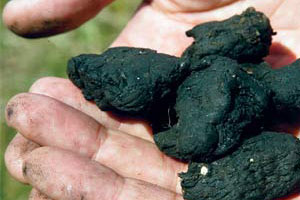
Photo: Manuel Balce Ceneta/AP Photos
IN AUGUST 1987, the National Park Service tore up the White House’s South Lawn and tilled in heaps of a new, locally produced fertilizer. The weedy plot’s transformation into a carpet of green caught gardeners’ attention, and soon there was a waiting list to buy bags of ComPRO, a compost made from nearby wastewater plants’ solid effluent, a.k.a. sewage sludge. Four years later, dumping sewage into the ocean was banned, and sludge went national. The Environmental Protection Agency launched a PR push to rebrand it as an all-purpose soil conditioner and fertilizer it innocuously called “biosolids.” If sludge was good enough for the first family, the agency reminded us, then surely it was good enough for the rest of America. “The Clintons are walking around on poo,” the EPA’s sludge chief quipped in 1998. “But it’s very clean poo.”
Today, more than half the 15 trillion gallons of sewage Americans flush annually is biologically scrubbed, “dewatered,” and processed into products with names like BioEdge, Nitrohumus, and Vital Cycle and spread on farmland, lawns, and home vegetable gardens. (The rest is incinerated or landfilled.) Recycling sewage is big business: In 2007 the Carlyle Group paid $772 million for the sludge-residuals company Synagro, whose products are the most popular on the market. Sludge could be the ultimate growth industry; as one trade publication observes dryly, “There will continue to be more wastewater solids to manage with every passing year.”
In theory, recycling poop is the perfect solution to the one truly unavoidable byproduct of human civilization. Turning sewage into a potent, inexpensive fertilizer means cleaner rivers and oceans. But as sludge has spread across the country, so have concerns that it may cause as many environmental problems as it solves. In communities where sludge has been used, residents have reported ailments ranging from migraines to pneumonia to mysterious deaths. In a 1994 episode often cited by sludge foes, an 11-year-old Pennsylvania boy died of a staph infection after biking through sludge at an abandoned mine.
Sludge’s dirty secret is that it may contain anything that goes down the drain—from Prozac flushed down toilets to motor oil hosed from factory floors. While sludge sold to consumers must be virtually pathogen free, sludge used on farms and industrial sites is permitted to contain low levels of human pathogens. A federal radiation task force recently warned that sludge might be contaminated with radioactive waste; in January, shipments of Canadian sludge with elevated radioactivity levels were turned back at the border. Food companies such as Del Monte and H.J. Heinz won’t accept produce grown on sludge-treated land. The Netherlands and Switzerland effectively ban the use of sludge on farmland, and 37 states regulate it more strictly than the EPA.
Despite the growing stink, the EPA has remained bullish on sludge through three presidential administrations. It points out that sludge has never been conclusively linked to any serious illnesses or deaths. Critics say the agency has consistently ignored the risks. “The fight over sludge is not about sewage; it’s about hiding industrial waste,” says Ed Hallman, an attorney for a former EPA scientist who has accused the agency of covering up the dangers of sludge. “The chemicals absorbed in sludge don’t exist anymore as far as the EPA is concerned. They are gone.”
COMPLAINTS ABOUT sludge usually begin with the smell. One morning last August, a manure spreader spewed a brown pudding on a field behind Barry Kimbrough’s house in Lawrence County, Alabama. “It smelled exactly like what it is—it smelled like shit,” recalls Kimbrough, a retiree with a small cattle ranch. “The odor was so bad, some people had to move out of their house for a week or so.” Other neighbors complained of breathing problems or pneumonia.
The EPA acknowledges that “biosolids may have their own distinctive odor,” but it doesn’t regulate their smell. Multiple studies have shown that severe odors can cause health problems, including depression and stress that can lead to chronic hypertension and heart disease. Jimmy Slaughter, a lawyer for Synagro, notes that smelling sludge can elicit “a visceral reaction.” Yet, he says, “If we were causing health problems, we would have known a long time ago.”
But the stench is just the start. A recent EPA survey of sludge samples from across the US found nearly universal contamination by 10 flame retardants and 12 pharmaceuticals and exceptionally high levels of endocrine disruptors such as triclosan, an ingredient in antibacterial soap that scientists believe is killing amphibians.
The EPA, however, hasn’t assessed the safety of many of these chemicals. (The Government Accountability Office recently concluded that the agency’s toxics program is “at serious risk of becoming obsolete.”) Though it limits the amount of toxic substances that can be dumped into the sewers, with the exception of several heavy metals such as cadmium and lead, the EPA doesn’t test for contaminants when they come out the other end of the pipes, where they may be concentrated in sludge. Some scientists are concerned that dangerous levels of contaminants from sludge are passing into crops and groundwater as well as blowing off fields and becoming airborne. Studies have shown that some chemicals in sludge can interact with one another to become more persistent or toxic. Other research has suggested that the toxins in sludge can pass into milk and meat.
In 1979, a Georgia dairyman named Andy McElmurray started applying locally produced sludge fertilizer to his fields. Over the next several years, nearly half his 700 cows died from severe diarrhea. The EPA didn’t test his soil, but McElmurray hired his own experts, who concluded that his sludge had contained high levels of thallium. A toxic metal that is the active ingredient in rat poison, thallium rarely turns up in sewage, but it was used as a catalyst by a nearby NutraSweet factory. When McElmurray’s experts sampled a local milk brand, they detected thallium at levels more than 11 times above the legal limit for drinking water.
McElmurray sued the federal government for disaster relief, claiming sludge had destroyed his farm. He finally won the case last year. “I believe that if the farmer knew the truth, he would never put sludge on his farmland,” he says. “It’s all a smoke-and-mirrors game that the EPA has played.” His view was echoed by the federal judge who ruled in his favor, finding that “senior EPA officials took extraordinary steps to quash scientific dissent and any questioning of the EPA’s biosolids program.”
Whistleblowers inside the agency have made similar claims. Last year, Hugh Kaufman, a former EPA investigator, testified in a lawsuit that former administrator Christine Todd Whitman prevented him from looking into the agency’s biosolids program. More than a decade earlier, David Lewis, a senior researcher at the EPA’s lab in Athens, Georgia, publicly criticized the agency for not doing enough research on sludge. In response, the EPA accused him of unlawfully engaging in a partisan debate. (The Labor Department overturned the complaint.) After Lewis continued to publish alarming studies about sludge in Nature and other journals, the EPA scientist in charge of promoting biosolids gave a sludge-company lawyer a Synagro document that said Lewis had been conducting “uninformed, unsupported, and otherwise unsound science.” (Lewis, who retired in 2003 and has since sued the EPA, declined to comment for this article.)
In 2002, the National Academy of Sciences joined the calls for more research. The EPA launched an ongoing round of studies in partnership with the Water Environment Research Foundation, the nonprofit research arm of the sewage industry’s main lobbying organization. In 2006, WERF funded Steve Wing, an epidemiology professor at the University of North Carolina, to develop a standardized way to track illnesses reported near sludge sites—something most experts agree is urgently needed. Wing says WERF pressured him “to keep the industry’s interest in mind” by micromanaging his work.
WERF “definitely can’t be trusted as an honest broker,” says John Stauber, coauthor of Toxic Sludge Is Good for You!, which exposed the hyping of sludge. “It’s like trusting the nuclear industry to be an honest broker when disposing of nuclear waste.” Dan Woltering, WERF’s head of research, denies that the group meddled with Wing’s research. WERF, he asserts, does “sound, peer-reviewed research” and does not have a policy agenda.
The official response to new discoveries of contaminated sludge remains tepid. In May 2007, the EPA learned that sludge had contaminated as many as 5,000 acres of grazing land about 25 miles from Kimbrough’s Alabama ranch with perfluorooctanoic acid (PFOA), a probable carcinogen used in Teflon. The chemical was traced back to a local manufacturer that had dumped contaminated wastewater straight into the sewer. The case prompted the EPA to issue its first-ever advisory on PFOA in drinking water, but it did not ban the dumping of the chemical into sewers or require sludge to be tested for it. Even though the exceedingly high PFOA concentrations in the Lawrence County fields could pose a health threat to animals or humans, as of press time, the Department of Agriculture hadn’t tested local cattle for the chemical.
Why does the EPA remain so unconcerned about sludge? Much of it is expediency, maintains Stauber. “You had some individuals who decided that ‘out of sight, out of mind’ would be the easiest way to handle this massive toxic disposal problem,” he says.
Suzanne Rudzinski, who oversees biosolids in the EPA’s Office of Water, says the agency’s approach has been prudent and balanced. “There’s always somebody, no matter who, that doesn’t like what the EPA is doing,” she says. She grants that the pervasiveness of flame retardants and other chemicals in sludge is a concern, but would like to see more research before recommending whether to regulate them. “I think we agree that there’s a lot more that we could learn,” she says, “and that’s what we’re trying to do.”
But Chris Nidel, the attorney for two Virginia families that recently resolved a lawsuit with Synagro, says the EPA’s wait-and-see stance is nothing but wishful thinking: “This is an experiment—with the initial results being negative—that we are going to continue ad nauseam until we have a regulatory agency that has a backbone.”
MIGHT THERE BE a better way to get rid of sludge? Perhaps, thanks to this nifty fact: A single American’s daily sludge output can generate enough power to light a 60-watt bulb for more than nine hours a day. Sludge is rich in methane, the main component of natural gas. That means that the wastewater sector, which uses about 1 percent of the nation’s electricity, could power itself with sludge and possibly have wattage to spare.
So far, however, fewer than 10 percent of the nation’s 6,000 public wastewater plants have anaerobic digesters that can extract methane from sludge; of those, just 20 percent burn the gas for energy. However, other promising projects are under way. Flint, Michigan, is one of several cities worldwide to fuel buses with gas from sludge. Last summer, Los Angeles began injecting sludge into a mile-deep well, where pressure and heat are expected to release enough methane to power 1,000 homes.
Sludge power is only a partial solution. At best, methane removal cuts sludge’s volume in half. Currently, leftover sludge is often incinerated, releasing heavy metals into the air and packing landfills with enough ash each year to fill more than 3,100 dump trucks. New high-efficiency poop-to-power plants can minimize those impacts. Using high-temperature or low-oxygen reactions, they covert sludge into a synthetic gas or oil, or a char similar to barbecue briquettes. The process can produce twice as much energy as it consumes, says Brian Dooley, a spokesman for Atlanta-based EnerTech, which built the first commercial plant of its kind in Southern California last year. The plant converts sludge from about a third of Los Angeles and Orange counties into a char that replaces coal at a local cement kiln; its ash is mixed into the cement. Such efforts, which reduce landfilling and emissions, have earned praise from some anti-sludge groups. Caroline Snyder, the founder of Citizens for Sludge-Free Land, calls it a “win-win situation.”
The EPA says sludge power holds promise, but it’s not quite ready to quit pushing sludge as a wonder fertilizer. This hasn’t deterred the sewage industry, which sees a chance to get into the renewable energy business and put a stop to the stream of health complaints and costly lawsuits. “After almost 40 years of working in biosolids,” a WERF official wrote in a recent newsletter, “I never thought I’d say this: it is an exciting time for sludge!”





